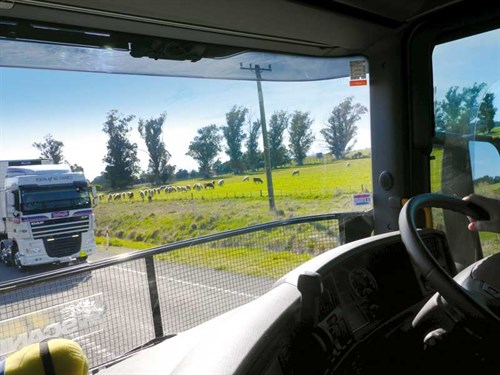Comment: Managing speed on NZ roads
Excess and inappropriate speed on the road is a major safety issue on New Zealand roads
In 2017, speeding was a contributing factor in 89 fatal crashes, 516 serious injury crashes, and 1345 minor injury crashes. Up until the end of May 2018, there has been 18,889 vehicle injury crashes; of these, 888 involved a truck.

The total social cost of all vehicle related crashes is about $4.7 Billion. Speed was a factor in 18% of all vehicle related crashes.
The faster a driver travels, the more likely they are to crash. As your speed increases, your stopping distance increases, your ability to safely corner or change direction quickly reduces, and it becomes harder for other road users to judge how fast you are travelling.
The severity of injuries resulting from a crash is directly related to the vehicle’s speed. The impact of a crash at 120kph is the equivalent force of jumping off a 20-storey high building. As a vehicle crashes, it decelerates immediately. Unfortunately, the occupants of the vehicle keep travelling at the previous speed, resulting in either serious injury or fatality.
The faster the speed, the more energy the human body needs to absorb. The faster the speed, the greater severity involved.
Much of New Zealand’s rural roading network was constructed to suit the 80kph speed limit that was in place at the time and is not built to safely sustain vehicle speeds over 100kph.
Excessive speed uses more fuel and wears vehicle consumable such as tyres at a quicker rate. A heavy truck and trailer travelling 500km per day can save an average of 50 litres of fuel by reducing their average speed by 5kph. Multiply that out over a working year and the savings are significant.
Most modern vehicles have been designed to create less noise and vibration and generally handle better. Unfortunately, these same design features insulate the drivers from the perception of danger when speeding and can influence speeding behaviour. Many vehicle safety initiatives have focused on reducing the severity of injury to vehicle occupants but haven’t necessarily reduced the number of vehicle crashes.
The faster a driver travels, the less time they have to react to a hazardous situation. As a general rule, each time you double the speed, you double the distance required to stop safely.
The faster you go, the greater the risk to vulnerable road users. If a pedestrian or cyclist is hit by a vehicle, the severity of their injuries is directly related to the impact speed. The probability of death rises steeply from 10% at an impact speed of 30kph to 70% at 50kph. The risks to elderly or children are even greater. Travelling at the legal maximum speed is not always appropriate for the conditions.
As a safe driver, you need to adjust your speed to the conditions, including:
- high traffic volumes vulnerable road users including pedestrians, cyclists, and runners
- holiday periods
- overseas drivers
- parked vehicles
- roadworks
- adverse weather, including rain, snow and ice, high winds, fog, and bright sunlight
If passing a school bus, no matter which direction you are travelling, you must slow down to 20kph. Keep an eye out for children who might run out from in front or behind the bus without looking. They are our most vulnerable road users; sometimes they make mistakes. They don’t deserve to pay for it with their life.
Road signs are there for a reason. They are there to warn you of hazards ahead. Changes in the road surface because of repair can affect your ability to brake quickly and to steer safely away from danger.
Loose stone from a road repair can be hazardous to both you and other road users. It takes several days for new road seal to settle and driving too fast can throw up chips that not only damage your vehicle but can also damage the new surface resulting in expensive repairs.
Road repair crews deserve our respect and need to have a safe workplace. Do the right thing and slow down to the posted speed and be ready to stop.
At roadworks, temporary speed restrictions will usually be in place. On active work sites, the temporary speed limit will be 30kph. For new seal or no road markings, the temporary speed limit will be either 50kph or 70kph. At many roadworks sites, traffic will be controlled by repair crew using stop/go signals.
These are there for the safety of the road repair crew and road users and so it’s important to not take these warnings lightly, as the consequences can be costly and sometimes fatal.
Failure to stop for a hand-held stop sign will incur 20 demerit points, plus a fine. Construction sites are regularly monitored by Police, and if you are caught speeding, you will be fined. Road repair crews are instructed to take down vehicle licence details of anyone driving in a careless or dangerous manner. This information is passed on to the Police.
Normal speeding fines and demerit points apply for exceeding temporary posted speed limits on work sites. As an example, exceeding the speed limit by 36kph will incur a fine of $400 and 50 demerit points. A total of 100 demerit points within a two-year period will see your licence suspended for three months. An immediate 28-day licence suspension applies if you are exceeding the speed limit by 50kph or more. Repeat offenders may have their vehicle impounded.
As an employer, you have a duty under Health and Safety legislation to monitor your employee’s behaviour on the road. One of the best ways to do this is by fitting your vehicles with GPS-based Telematics that reports driver behaviour in real time.
Monitoring and reporting speeding, fuel use, driver hours, harsh cornering, and harsh braking. As an employer, this gives you the tools needed to assist with managing your employee’s behaviour on the road, helping you to manage driver fatigue and assisting with driver training. Fitting a two-way dash cam camera system also assists with managing driver behaviour and assists in identifying other road user’s behaviour. As an employer, your health and safety requirements should include a safe driving policy.
This policy should include an employee code of conduct that covers the employer’s expectations relating to:
- excess speed
- driving in a reckless or dangerous manner
- managing fatigue
- driving under the influence of drugs and or alcohol
- demerit points and loss of licence
Keep up to date in the industry by signing up to Deals on Wheels' free newsletter or liking us on Facebook.





.jpg)


.jpg)








